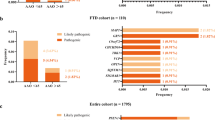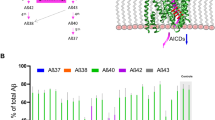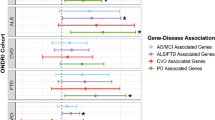Abstract
Many individuals with Parkinson’s disease (PD) develop cognitive deficits, and a phenotypic and molecular overlap between neurodegenerative diseases exists. We investigated the contribution of rare variants in seven genes of known relevance to dementias (β-amyloid precursor protein (APP), PSEN1/2, MAPT (microtubule-associated protein tau), fused in sarcoma (FUS), granulin (GRN) and TAR DNA-binding protein 43 (TDP-43)) to PD and PD plus dementia (PD+D) in a discovery sample of 376 individuals with PD and followed by the genotyping of 25 out of the 27 identified variants with a minor allele frequency <5% in 975 individuals with PD, 93 cases with Lewy body disease on neuropathological examination, 613 individuals with Alzheimer’s disease (AD), 182 cases with frontotemporal dementia and 1014 general population controls. Variants identified in APP were functionally followed up by Aβ mass spectrometry in transiently transfected HEK293 cells. PD+D cases harbored more rare variants across all the seven genes than PD individuals without dementia, and rare variants in APP were more common in PD cases overall than in either the AD cases or controls. When additional controls from publically available databases were added, one rare variant in APP (c.1795G>A(p.(E599K))) was significantly associated with the PD phenotype but was not found in either the PD cases or controls of an independent replication sample. One of the identified rare variants (c.2125G>A (p.(G709S))) shifted the Aβ spectrum from Aβ40 to Aβ39 and Aβ37. Although the precise mechanism remains to be elucidated, our data suggest a possible role for APP in modifying the PD phenotype as well as a general contribution of genetic factors to the development of dementia in individuals with PD.
Similar content being viewed by others
Log in or create a free account to read this content
Gain free access to this article, as well as selected content from this journal and more on nature.com
or
References
Deramecourt V, Bombois S, Maurage CA et al: Biochemical staging of synucleinopathy and amyloid deposition in dementia with Lewy bodies. J Neuropathol Exp Neurol 2006; 65: 278–288.
Hutton M, Lendon CL, Rizzu P et al: Association of missense and 5'-splice-site mutations in tau with the inherited dementia FTDP-17. Nature 1998; 393: 702–705.
Pastor P, Ezquerra M, Munoz E et al: Significant association between the tau gene A0/A0 genotype and Parkinson's disease. Ann Neurol 2000; 47: 242–245.
Simon-Sanchez J, Schulte C, Bras JM et al: Genome-wide association study reveals genetic risk underlying Parkinson's disease. Nat Genet 2009; 41: 1308–1312.
Aarsland D, Andersen K, Larsen JP, Lolk A, Kragh-Sorensen P : Prevalence and characteristics of dementia in Parkinson disease: an 8-year prospective study. Arch Neurol 2003; 60: 387–392.
Riedel O, Klotsche J, Spottke A et al: Cognitive impairment in 873 patients with idiopathic Parkinson's disease. Results from the German Study on Epidemiology of Parkinson's Disease with Dementia (GEPAD). J Neurol 2008; 255: 255–264.
Kempster PA, O'Sullivan SS, Holton JL, Revesz T, Lees AJ. : Relationships between age and late progression of Parkinson's disease: a clinico-pathological study. Brain 2010; 133: 1755–1762.
Goate A, Chartier-Harlin MC, Mullan M et al: Segregation of a missense mutation in the amyloid precursor protein gene with familial Alzheimer's disease. Nature 1991; 349: 704–706.
Levy-Lahad E, Wasco W, Poorkaj P et al: Candidate gene for the chromosome 1 familial Alzheimer's disease locus. Science 1995; 269: 973–977.
Rogaev EI, Sherrington R, Rogaeva EA et al: Familial Alzheimer's disease in kindreds with missense mutations in a gene on chromosome 1 related to the Alzheimer's disease type 3 gene. Nature 1995; 376: 775–778.
Sherrington R, Rogaev EI, Liang Y et al: Cloning of a gene bearing missense mutations in early-onset familial Alzheimer's disease. Nature 1995; 375: 754–760.
Cruts M, Gijselinck I, van der Zee J et al: Null mutations in progranulin cause ubiquitin-positive frontotemporal dementia linked to chromosome 17q21. Nature 2006; 442: 920–924.
Neumann M, Rademakers R, Roeber S, Baker M, Kretzschmar HA, Mackenzie IR. : A new subtype of frontotemporal lobar degeneration with FUS pathology. Brain 2009; 132: 2922–2931.
Neumann M, Sampathu DM, Kwong LK et al: Ubiquitinated TDP-43 in frontotemporal lobar degeneration and amyotrophic lateral sclerosis. Science 2006; 314: 130–133.
Emre M, Aarsland D, Brown R et al: Clinical diagnostic criteria for dementia associated with Parkinson's disease. Mov Disord 2007; 22: 1689–1707, quiz 1837.
Winkelmann J, Czamara D, Schormair B et al: Genome-wide association study identifies novel restless legs syndrome susceptibility loci on 2p14 and 16q12.1. PLoS Genet 2011; 7: e1002171.
(ESP) NGESP. Exome Variant Server. Available at http://evs.gs.washington.edu/EVS/ Accessed on December 1, 2012.
Lei P, Ayton S, Finkelstein DI et al: Tau deficiency induces parkinsonism with dementia by impairing APP-mediated iron export. Nat Med 2012; 18: 291–295.
Ross OA, Soto-Ortolaza AI, Heckman MG et al: Association of LRRK2 exonic variants with susceptibility to Parkinson's disease: a case-control study. Lancet Neurol 2011; 10: 898–908.
Guo JP, Arai T, Miklossy J, McGeer PL : Abeta and tau form soluble complexes that may promote self aggregation of both into the insoluble forms observed in Alzheimer's disease. Proc Natl Acad Sci USA 2006; 103:1953–1958.
Ousson S, Saric A, Baguet A et al: Substrate determinants in the C99 juxtamembrane domains differentially affect gamma-secretase cleavage specificity and modulator pharmacology. J Neurochem 2013; 125: 610–619.
Haass C, Kaether C, Thinakaran G, Sisodia S : Trafficking and proteolytic processing of APP. Cold Spring Harb Perspect Med 2012; 2: a006270.
Duce JA, Ayton S, Miller AA et al: Amine oxidase activity of beta-amyloid precursor protein modulates systemic and local catecholamine levels. Mol Psychiatry 2013; 18: 245–254.
Duce JA, Tsatsanis A, Cater MA et al: Iron-export ferroxidase activity of beta-amyloid precursor protein is inhibited by zinc in Alzheimer's disease. Cell 2010; 142: 857–867.
Dexter DT, Wells FR, Agid F et al: Increased nigral iron content in postmortem parkinsonian brain. Lancet 1987; 2: 1219–1220.
Acknowledgements
We are very grateful to Jelena Golic, Susanne Lindhof, Katja Junghans, Regina Feldmann and Sybille Frischholz at the Institute for Human Genetics at the Helmholtz Zentrum München for expert technical assistance.
All variants were submitted to dbSNP and received the NCBI numbers ss1399967350 to ss1399967376.
Author information
Authors and Affiliations
Corresponding author
Ethics declarations
Competing interests
This study was funded exclusively by in-house institutional funding from the Technische Universität München and the Helmholtz Zentrum München, Munich, Germany. There was no industry sponsorship. The KORA-Age project was funded by the German Ministry for Education and Research (BMBF) FKZ 01ET0713 and 01ET1003. BM has received grants from TEVA-Pharma, Desitin, Boehringer-Ingelheim and GE Healthcare and honoraria for consultancy from Bayer Schering Pharma AG and for presentations from GlaxoSmithKline and Orion Pharma as well as travel and meeting expenses from Boehringer-Ingelheim and Novartis. DH is currently employed by the Medical University of Vienna, Austria, and received research support through the National Institute of Neurological Disorders and Stroke Intramural Research Program and the Austrian Science Fund (FWF). He serves as member of the Medical Advisory Board of the International Essential Tremor Foundation and received honoraria and conference support from Ipsen and UCB. Walter Pirker received speaker honoraria from AOP Orphan Pharma, Medtronic Inc., Novartis, Boehringer-Ingelheim, Abbott Pharm and UCB as well as travel compensation from Ipsen Pharma, Boehringer-Ingelheim and Medtronic, Inc. BB and MJM receive research support from the Hungarian National Innovation Office (TÁMOP-4-2-1/B-03/1/KMR-2010-001). The functional analyses were supported by the European Research Council under the European Union's Seventh Framework Program (FP7/20072013)/ ERC Grant Agreement No. 321366-Amyloid (advanced grant to CH) and the general legacy of Mrs Ammer (to the Ludwig-Maximilians University/the chair of C.H.). PP is funded by a grant of the Spanish Ministry of Science and Innovation SAF-2010-22329-C02-01: 2011–2013. XE is funded by the Spanish Plan Nacional SAF-2008-00357 (NOVADIS); the Generalitat de Catalunya AGAUR 2009 SGR-1502; and the European Commission 7th Framework Program, Project No 261123 (GEUVADIS) and Project No 262055 (ESGI). JW serves on a scientific advisory board for UCB and has received speaker honoraria from UCB and Vifor Pharma. The remaining authors declare no conflict of interest.
Additional information
Supplementary Information accompanies this paper on European Journal of Human Genetics website
Supplementary information
Rights and permissions
About this article
Cite this article
Schulte, E., Fukumori, A., Mollenhauer, B. et al. Rare variants in β-Amyloid precursor protein (APP) and Parkinson’s disease. Eur J Hum Genet 23, 1328–1333 (2015). https://doi.org/10.1038/ejhg.2014.300
Received:
Revised:
Accepted:
Published:
Issue date:
DOI: https://doi.org/10.1038/ejhg.2014.300
This article is cited by
-
A thermodynamic investigation of amyloid precursor protein processing by human γ-secretase
Communications Biology (2022)
-
Genetic landscape of early-onset dementia in Hungary
Neurological Sciences (2022)
-
Reduced erythrocytic CHCHD2 mRNA is associated with brain pathology of Parkinson’s disease
Acta Neuropathologica Communications (2021)
-
Whole-exome sequencing of Finnish patients with vascular cognitive impairment
European Journal of Human Genetics (2021)
-
Singular cases of Alzheimer’s disease disclose new and old genetic “acquaintances”
Neurological Sciences (2021)



